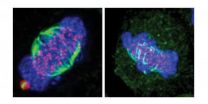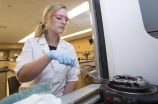First beef with the goodness of fish
The fatty acid profile of beef can be improved to boost levels of omega-3s
2015-05-11
(Press-News.org) Chinese scientists have reared beef rich in the beneficial fatty acids associated with fish oils. The study in Springer's journal Biotechnology Letters also highlights the scientific challenges that remain.
The team from Northwest A&F University and the National Beef Cattle Improvement Centre, both in Yangling (Shaanxi), successfully introduced a gene into foetal cells from Luxi Yellow cattle, a Chinese breed with a high beef yield. The fat1 gene, isolated from a nematode worm, codes for desaturase enzymes that are involved in the conversion of n-6 to n-3 polyunsaturated fatty acids.
A diet rich in long chain n-3 polyunsaturated fatty acids, also known as omega-3 oils, can help protect against cardiovascular diseases, obesity and neurodegenerative diseases. However, levels of these fatty acids in the human diet have decreased over the years and the levels of shorter chain n-6 fatty acids have increased. Introducing the fat1 gene to cattle increased the levels of beneficial oils by over five times.
"We have provided the first evidence that it is possible to create a new breed of cattle with higher nutritional value in terms of their fatty acid composition," says corresponding author Linsen Zan from the College of Animal Science and Technology at the university.
Other research groups are experimenting with increasing levels of omega-3 oils in farmed fish by creating fishmeal rich in a new plant source. A similar strategy could be used for cattle - producing feedstock rich in omega-3s - but the new study shows that elevated levels can be directly produced in beef. Similar genes have previously been introduced to pigs, dairy cattle and sheep by international research groups.
Of 14 calves that successfully received the fat1 gene, 11 died at less than four months old, mainly from inflammation and from an infection common to cattle, haemorrhagic septicaemia. Further research is needed to determine the causes. Abnormalities may result from the incomplete reprogramming of cells or from some genes being turned on and off during the generation of embryos.
"There is much to learn about the best scientific techniques and the best husbandry required to make beef a rich animal source of omega-3 oils for human nutrition, but we have taken the first step," says lead author Gong Cheng. The researchers believe that the results of their study could help ensure in the future that the beef that people eat is better for them.
INFORMATION:
Reference: Cheng, G. et al: (2015). Production of transgenic beef cattle rich in n-3 PUFAs by somatic cell nuclear transfer. Biotechnology Letters; DOI 10.1007/s10529-015-1827-z
ELSE PRESS RELEASES FROM THIS DATE:
2015-05-11
How much food your dining companion eats can have a big influence on how much you consume, a UNSW Australia-led study concludes.
This psychological effect, known as social modelling, leads people to eat less than they normally would if alone when their companion consumes a small amount of food.
Study lead author, Associate Professor Lenny Vartanian of the UNSW School of Psychology, says that in social situations the appropriate amount of food to eat can be unclear.
"Internal signals like hunger and feeling full can often be unreliable guides. In these situations people ...
2015-05-11
An international consortium of scientists led by a group from the University of Leicester has announced a new advance in understanding the mechanisms of cancer and how to target it more effectively with new treatments.
Two papers published in the same issue of the world-leading Journal of Cell Biology have arisen from research work led by Professor Andrew Fry at the University of Leicester. Both papers suggest that new understanding of the mechanics of cell division can reveal new targets for cancer therapy.
Professor Fry, who is Director of Research in the College ...
2015-05-11
Geoscientists have, for the first time, discovered the origins of Australia's two largest basins: Lake Eyre and the Murray-Darling Basin. The research also implies that in 30 million years' time both basins will cease to exist.
Monash University geoscientist Associate Professor Wouter Schellart, and his colleague Professor Wim Spakman from Utrecht University, have discovered how the floor of an entire ocean basin that was destroyed 70 to 50 million years ago off the North coast of New Guinea is currently located at 800-1200km depth below Central and South-eastern Australia.
Using ...
2015-05-11
New scanning methods which map the wiring of the brain could provide a valuable new tool to predict people at risk of schizophrenia, according to a new study.
Scientists have long known that the symptoms of schizophrenia are partly explained by disordered connectivity in the brain.
Now, a team of scientists from Cardiff University Brain Research Imaging Centre (CUBRIC), the Institute of Psychiatry, Psychology and Neuroscience, Kings College London and the University of Bristol, have, for the first time, used Magnetic Resonance Imaging (MRI) to identify how the ...
2015-05-11
Myopia or short-sightedness is becoming more common across Europe, according to a new study led by King's College London. The meta-analysis of findings from 15 studies by the European Eye Epidemiology Consortium found that around a quarter of the European population is short-sighted but it is nearly twice as common in younger people, with almost half (47 per cent) of the group aged between 25 and 29 years affected.
The analysis of studies covering over 60,000 people, which was published today in the journal Ophthalmology, also found a strong link between myopia and level ...
2015-05-11
New research suggests the use of hookah steam stones - commonly considered a safer alternative to cigarette smoking - could be leaving users with a dangerous, false sense of security. The findings out of the University of Cincinnati/Agilent Technologies Metallomics Center of the Americas are published this month in the Microchemical Journal.
An analysis led by Amberlie Clutterbuck, a doctoral student in the UC Department of Chemistry, found residues of toxic metals that included chromium, arsenic and cadmium following several simulated hookah/steam stones smoking scenarios.
Clutterbuck's ...
2015-05-11
Philadelphia, PA, May 11, 2015 -- Dopamine is the chemical messenger in the brain most closely associated with pleasure and reward. Recent scientific advances now shed light on precise roles for dopamine in the reward process.
A new paper published in the current issue of Biological Psychiatry implicates dopamine in a person's ability to be motivated by delayed rewards.
People like immediate reinforcement and tend to devalue rewards that are substantially delayed in time. As a result, people will often opt for smaller immediate rewards as opposed to larger delayed rewards ...
2015-05-11
Even with the best available treatments, the median survival of patients with metastatic, hormone-refractory prostate cancer is only two to three years. Driven by the need for more effective therapies for these patients, researchers at VCU Massey Cancer Center and the VCU Institute of Molecular Medicine (VIMM) have developed a unique approach that uses microscopic gas bubbles to deliver directly to the cancer a viral gene therapy in combination with an experimental drug that targets a specific gene driving the cancer's growth.
Recently published in the journal Oncotarget, ...
2015-05-11
CORVALLIS, Ore. - Scientists at Oregon State University have developed a faster, more accurate method to assess cancer risk from certain common environmental pollutants.
Researchers found that they could analyze the immediate genetic responses of the skin cells of exposed mice and apply statistical approaches to determine whether or not those cells would eventually become cancerous.
The study focused on an important class of pollutants known as polycyclic aromatic hydrocarbons, or PAHs, that commonly occur in the environment as mixtures such as diesel exhaust and cigarette ...
2015-05-11
Swollen lymph nodes are often the earliest sign of metastatic spread of cancer cells. Now cancer researchers and immunologists at Sweden's Karolinska Institutet have discovered how cancer cells can infiltrate the lymphatic system by 'disguising' themselves as immune cells (white blood cells). The researchers hope that this finding, which is published in the scientific journal Oncogene, will inform the development of new drugs.
The main reason why people die of cancer is that the cancer cells spread to form daughter tumours, or metastases, in vital organs, such as the ...
LAST 30 PRESS RELEASES:
[Press-News.org] First beef with the goodness of fish
The fatty acid profile of beef can be improved to boost levels of omega-3s



